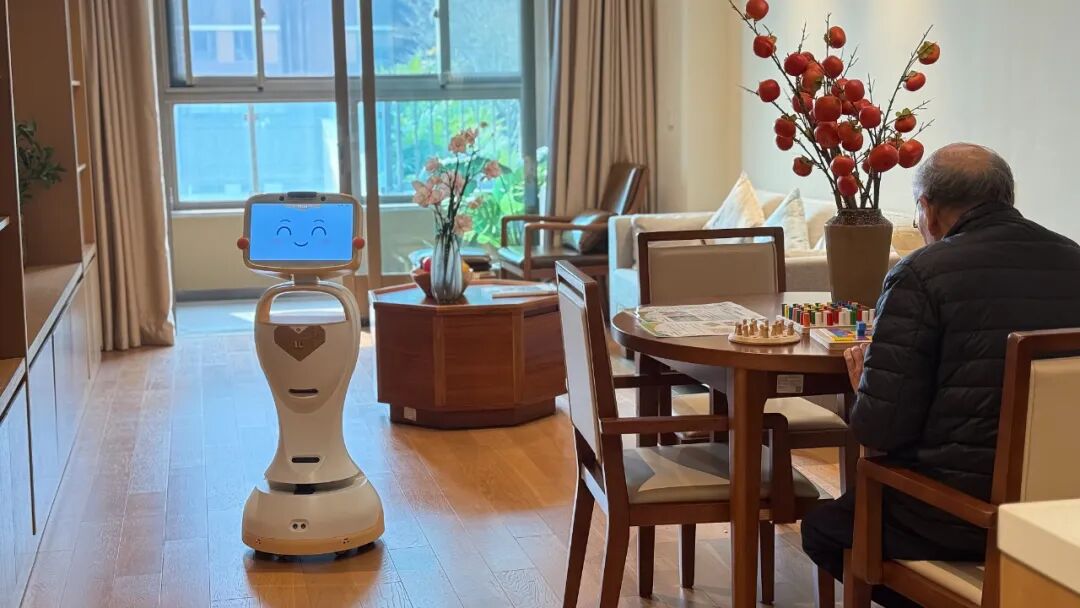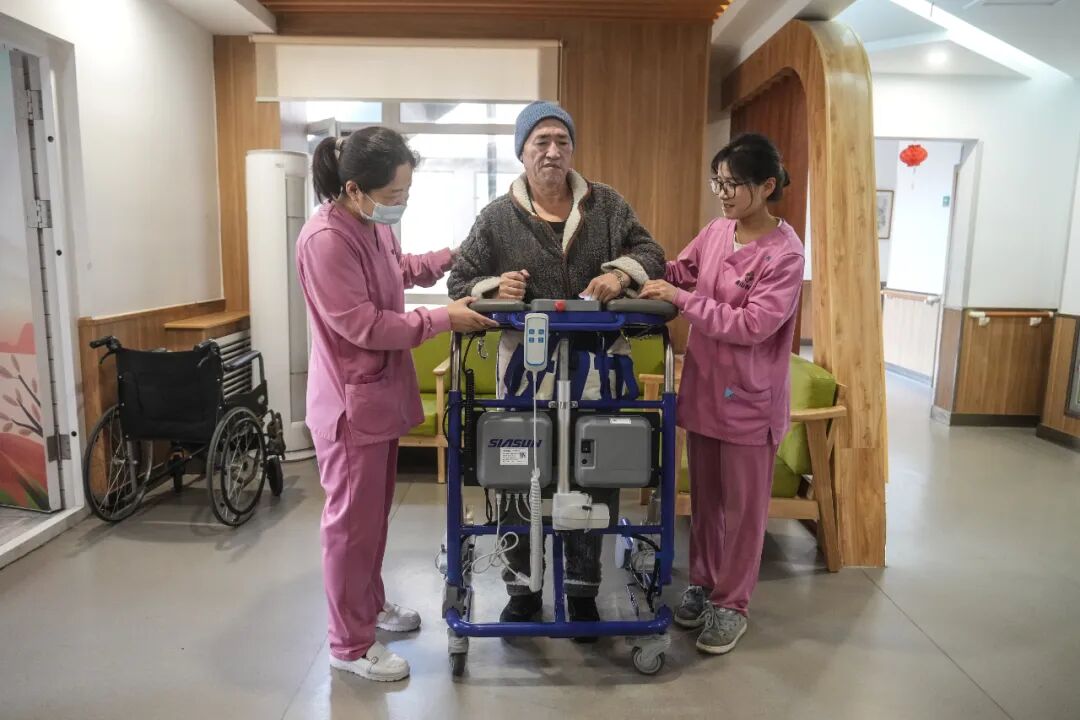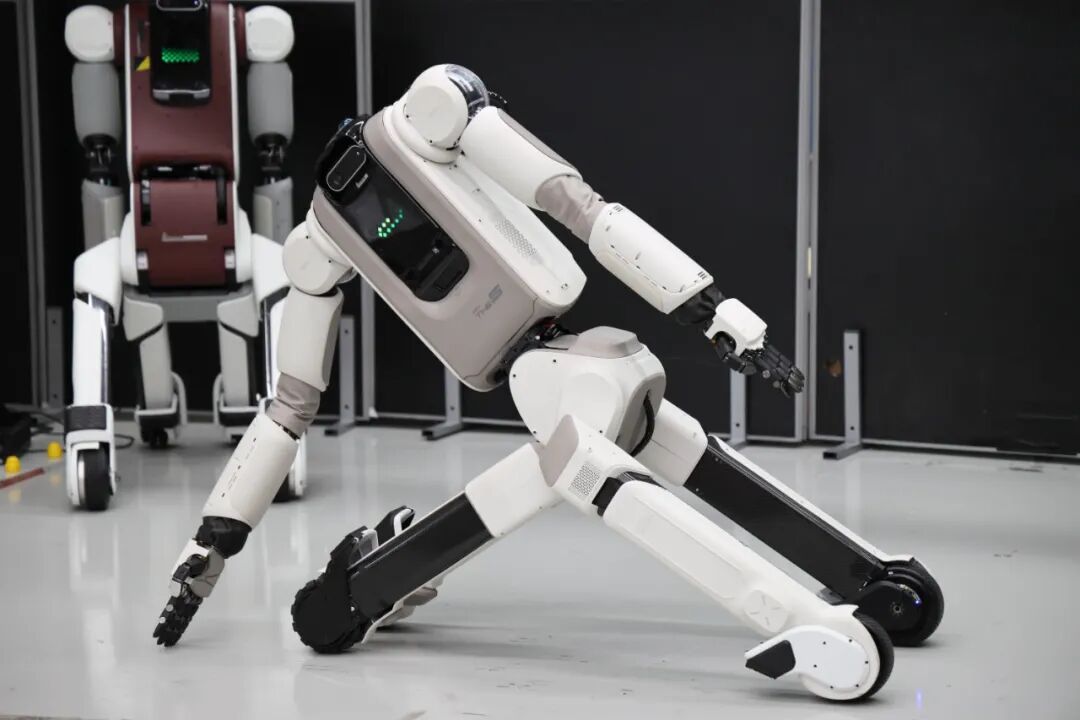Recently, the International Electrotechnical Commission (IEC) officially released the international standard for elderly care robots, which was led by China. This standard provides benchmarks for the design, manufacturing, testing, and certification of various elderly care robot products.Is the era of elderly care robots upon us? Are elderly care robots reliable? Reporters from “Xinhua Insight” conducted interviews on this topic.The Era of Elderly Care Robots Has ArrivedRecently, in the Taibao Jiayuan Chengdu community, at seven in the morning, the robot “Yangyang” automatically woke up and began to silently walk around the house searching for people. It arrived at Grandma Li’s bedside.“Good morning, Grandma.”“Good morning, Yangyang.”“Yangyang” started to report the weather for the day and then reminded Grandma Li to participate in the flower arrangement activity at the elderly care facility at ten o’clock in the morning. The elderly companion robot “Yangyang” is a collaboration between the Institute of Robotics Service at Zhongke Source and the Taibao Jiayuan Chengdu community. (Provided by the interviewee)Elderly care robots are rapidly entering real life.During this year’s Spring Festival, a short video of an exoskeleton robot assisting elderly people in climbing Mount Tai sparked heated discussions on social media both domestically and internationally. “The robot helps elderly people climb mountains, showing us more of the actual needs of the elderly,” said Yu Yunbo, General Manager of Shenzhen Kenking Technology Co., Ltd.Interviews revealed that currently, elderly care robots on the market can be mainly divided into three categories based on their functions and application scenarios: first, rehabilitation robots, which assist disabled elderly people in regaining mobility, such as lower limb walkers and walking assist robots; second, nursing robots, which primarily provide daily care services for the elderly, such as electric nursing beds, health monitoring, and emergency assistance; third, companion robots, which include functions such as emotional interaction, entertainment companionship, and home management.Compared to industrial robots, elderly care robots are still in the early stages of development, but some users have already experienced the convenience brought by related products.Mr. Zhang, a seventy-year-old from Shenyang, Liaoning, who previously suffered from a cerebral infarction, uses a lower limb exoskeleton trainer produced by Shenyang Xinsong Robot Automation Co., Ltd. With the help of the device, he has gradually progressed from basic movements like foot flexion and leg lifting to step training, climbing stairs, and squatting with support, eventually being able to walk with the correct posture.
The elderly companion robot “Yangyang” is a collaboration between the Institute of Robotics Service at Zhongke Source and the Taibao Jiayuan Chengdu community. (Provided by the interviewee)Elderly care robots are rapidly entering real life.During this year’s Spring Festival, a short video of an exoskeleton robot assisting elderly people in climbing Mount Tai sparked heated discussions on social media both domestically and internationally. “The robot helps elderly people climb mountains, showing us more of the actual needs of the elderly,” said Yu Yunbo, General Manager of Shenzhen Kenking Technology Co., Ltd.Interviews revealed that currently, elderly care robots on the market can be mainly divided into three categories based on their functions and application scenarios: first, rehabilitation robots, which assist disabled elderly people in regaining mobility, such as lower limb walkers and walking assist robots; second, nursing robots, which primarily provide daily care services for the elderly, such as electric nursing beds, health monitoring, and emergency assistance; third, companion robots, which include functions such as emotional interaction, entertainment companionship, and home management.Compared to industrial robots, elderly care robots are still in the early stages of development, but some users have already experienced the convenience brought by related products.Mr. Zhang, a seventy-year-old from Shenyang, Liaoning, who previously suffered from a cerebral infarction, uses a lower limb exoskeleton trainer produced by Shenyang Xinsong Robot Automation Co., Ltd. With the help of the device, he has gradually progressed from basic movements like foot flexion and leg lifting to step training, climbing stairs, and squatting with support, eventually being able to walk with the correct posture. On March 11, at an elderly care facility in Hunnan District, Shenyang, a caregiver assists an elderly person using an electric standing walker produced by Xinsong Company. Xinhua News Agency reporter Pan Yulong photographed this.“The standardization of elderly care facility scenarios is very suitable for robot applications,” said Xu Zhenfa, Deputy Director of the Institute of Robotics Service at Zhongke Source. “But this is just the first step; only by entering thousands of households can the elderly care robot market experience a major explosion.”When Will They Enter Ordinary Households?Interviews revealed that although the development prospects for elderly care robots are broad, there are still challenges such as immature technology, generally high prices, and insufficient supporting services, making it difficult for them to enter ordinary households.In a Shenzhen elderly care facility, elderly people can play chess with robots in the chess activity room and enjoy robot-assisted moxibustion therapy in the therapy room. However, the operations such as turning on the robot are relatively complex and require assistance from caregivers. The humanoid robot tested here has weak language recognition and understanding capabilities, moves slowly, and lacks adaptability to complex environments.Many industry insiders told reporters that the current perception and interaction capabilities of products are still a pressing issue for elderly care robots. “From a technical perspective, the ‘small brain’ and ‘limb’ parts of the robot are already quite developed, but the technology in the ‘big brain’ aspect still needs breakthroughs,” said Chen Yang, Deputy General Manager of the Chengdu Humanoid Robot Innovation Center.
On March 11, at an elderly care facility in Hunnan District, Shenyang, a caregiver assists an elderly person using an electric standing walker produced by Xinsong Company. Xinhua News Agency reporter Pan Yulong photographed this.“The standardization of elderly care facility scenarios is very suitable for robot applications,” said Xu Zhenfa, Deputy Director of the Institute of Robotics Service at Zhongke Source. “But this is just the first step; only by entering thousands of households can the elderly care robot market experience a major explosion.”When Will They Enter Ordinary Households?Interviews revealed that although the development prospects for elderly care robots are broad, there are still challenges such as immature technology, generally high prices, and insufficient supporting services, making it difficult for them to enter ordinary households.In a Shenzhen elderly care facility, elderly people can play chess with robots in the chess activity room and enjoy robot-assisted moxibustion therapy in the therapy room. However, the operations such as turning on the robot are relatively complex and require assistance from caregivers. The humanoid robot tested here has weak language recognition and understanding capabilities, moves slowly, and lacks adaptability to complex environments.Many industry insiders told reporters that the current perception and interaction capabilities of products are still a pressing issue for elderly care robots. “From a technical perspective, the ‘small brain’ and ‘limb’ parts of the robot are already quite developed, but the technology in the ‘big brain’ aspect still needs breakthroughs,” said Chen Yang, Deputy General Manager of the Chengdu Humanoid Robot Innovation Center. On March 5, in Tencent’s Robotics X laboratory, the fifth-generation robot “Xiao Wu” demonstrated its automatic folding and storage function. Xinhua News Agency reporter Liang Xu photographed this.The prices of elderly care robots are also generally high. A search on e-commerce platforms revealed that a smart elderly care robot with AI human-machine interaction dialogue and online medical consultation functions costs over 140,000 yuan, while some walking assist robots range from 10,000 to 30,000 yuan, and high-end rehabilitation robots generally exceed 100,000 yuan, with bathing robots averaging between 30,000 and 50,000 yuan.During this year’s National People’s Congress, “AI + Elderly Care” became a hot topic among representatives and committee members. The government work report proposed establishing a growth mechanism for future industry investment, cultivating future industries such as biomanufacturing, quantum technology, embodied intelligence, and 6G. The industry generally holds an optimistic attitude towards the future development of elderly care robots.Li Qingfeng, a representative of the National People’s Congress and Chairman of iFlytek, stated that it is expected that in about three years, companion elderly care robots will enter households; while robots capable of providing care services for disabled and semi-disabled elderly people, similar to professional caregivers, are expected to enter households in about five years.“Robots will eventually enter thousands of households. Before this goal is achieved, there may be a phase of ‘big brother’ robots, where functions are gradually improved and costs are gradually reduced,” said Zhang Zhengyou, Chief Scientist at Tencent and Director of Tencent’s Robotics X laboratory.Accelerating the Entry of Elderly Care Robots into the ‘Silver Economy’According to data from the National Bureau of Statistics, by the end of 2024, the population aged 60 and above in China will exceed 300 million, accounting for 22%; the population aged 65 and above will exceed 200 million, accounting for over 15%. The emergence of elderly care robots is expected to alleviate the burden of care for the elderly on society and families, helping elderly people live with dignity.Interviews revealed that in some nursing homes, nearly 80% of disabled elderly people have walking assistance needs, and over 20% require bathing support due to mobility limitations.In January of this year, the Central Committee of the Communist Party of China and the State Council issued opinions on deepening the reform and development of elderly care services, proposing to accelerate the development and application of elderly care technology and information technology. The emergence of large models like DeepSeek provides strong momentum for the deep integration of technology and elderly care.“Currently, the vision for elderly care robots is about to explode, which is a positive development for the industry,” said Bi Yale, Secretary-General of the Shenzhen Robot Association. Currently, there is significant demand for elderly care robots that assist with bathing, dining, and walking, and in the near future, these robots that address current elderly care pain points will be favored by the market.Industry insiders suggest encouraging companies to develop affordable products, such as walking aids priced below 5,000 yuan; considering establishing a rental system for elderly care robots to lower the threshold for family use. It is also important to integrate robots into a “comprehensive care” system, collaborating with caregivers and social workers, where robots handle basic care while humans focus on emotional support.Interviewees believe that there is still a certain degree of lack in service standards, quality assessment systems, and relevant laws and regulations for elderly care robots. The next step should be to accelerate legislation and standardization in the field of elderly care robots. At the same time, training should be conducted to help elderly people overcome technological fears, allowing them to truly experience the convenience of digital life in their daily lives.“In developing elderly care robots, we must not overlook the companionship of children for the elderly. The emotional bond is something that machines cannot replace. Over-reliance on elderly care robots may lead to mental health issues for the elderly. We need to combine technology with humanistic care, allowing elderly people to enjoy the convenience brought by technology while also feeling the warmth of humanity,” said Wei Hongmin, Deputy Dean of the College of Applied Technology at Anshan Normal University.
On March 5, in Tencent’s Robotics X laboratory, the fifth-generation robot “Xiao Wu” demonstrated its automatic folding and storage function. Xinhua News Agency reporter Liang Xu photographed this.The prices of elderly care robots are also generally high. A search on e-commerce platforms revealed that a smart elderly care robot with AI human-machine interaction dialogue and online medical consultation functions costs over 140,000 yuan, while some walking assist robots range from 10,000 to 30,000 yuan, and high-end rehabilitation robots generally exceed 100,000 yuan, with bathing robots averaging between 30,000 and 50,000 yuan.During this year’s National People’s Congress, “AI + Elderly Care” became a hot topic among representatives and committee members. The government work report proposed establishing a growth mechanism for future industry investment, cultivating future industries such as biomanufacturing, quantum technology, embodied intelligence, and 6G. The industry generally holds an optimistic attitude towards the future development of elderly care robots.Li Qingfeng, a representative of the National People’s Congress and Chairman of iFlytek, stated that it is expected that in about three years, companion elderly care robots will enter households; while robots capable of providing care services for disabled and semi-disabled elderly people, similar to professional caregivers, are expected to enter households in about five years.“Robots will eventually enter thousands of households. Before this goal is achieved, there may be a phase of ‘big brother’ robots, where functions are gradually improved and costs are gradually reduced,” said Zhang Zhengyou, Chief Scientist at Tencent and Director of Tencent’s Robotics X laboratory.Accelerating the Entry of Elderly Care Robots into the ‘Silver Economy’According to data from the National Bureau of Statistics, by the end of 2024, the population aged 60 and above in China will exceed 300 million, accounting for 22%; the population aged 65 and above will exceed 200 million, accounting for over 15%. The emergence of elderly care robots is expected to alleviate the burden of care for the elderly on society and families, helping elderly people live with dignity.Interviews revealed that in some nursing homes, nearly 80% of disabled elderly people have walking assistance needs, and over 20% require bathing support due to mobility limitations.In January of this year, the Central Committee of the Communist Party of China and the State Council issued opinions on deepening the reform and development of elderly care services, proposing to accelerate the development and application of elderly care technology and information technology. The emergence of large models like DeepSeek provides strong momentum for the deep integration of technology and elderly care.“Currently, the vision for elderly care robots is about to explode, which is a positive development for the industry,” said Bi Yale, Secretary-General of the Shenzhen Robot Association. Currently, there is significant demand for elderly care robots that assist with bathing, dining, and walking, and in the near future, these robots that address current elderly care pain points will be favored by the market.Industry insiders suggest encouraging companies to develop affordable products, such as walking aids priced below 5,000 yuan; considering establishing a rental system for elderly care robots to lower the threshold for family use. It is also important to integrate robots into a “comprehensive care” system, collaborating with caregivers and social workers, where robots handle basic care while humans focus on emotional support.Interviewees believe that there is still a certain degree of lack in service standards, quality assessment systems, and relevant laws and regulations for elderly care robots. The next step should be to accelerate legislation and standardization in the field of elderly care robots. At the same time, training should be conducted to help elderly people overcome technological fears, allowing them to truly experience the convenience of digital life in their daily lives.“In developing elderly care robots, we must not overlook the companionship of children for the elderly. The emotional bond is something that machines cannot replace. Over-reliance on elderly care robots may lead to mental health issues for the elderly. We need to combine technology with humanistic care, allowing elderly people to enjoy the convenience brought by technology while also feeling the warmth of humanity,” said Wei Hongmin, Deputy Dean of the College of Applied Technology at Anshan Normal University.
Is the Era of Elderly Care Robots Coming?
What are your thoughts on elderly care robots? Feel free to leave your comments in the discussion section.
Source: Xinhua News Agency Editor: Luo Chunjiao Second Review: Yu Qiangnian Third Review: Gao Xiaoyan
 1. Traffic violations exposed! 2. Gas suspension notice! Involves these areas → 3. Suddenly went viral! Doctors: Not scientific! Do not use!
1. Traffic violations exposed! 2. Gas suspension notice! Involves these areas → 3. Suddenly went viral! Doctors: Not scientific! Do not use!